Structured Literacy:
Whole class spelling in Year 7 & 8
A description of a super-fantastic lesson, with planning and resources to download so you can try it out yourself!
Estimated read time: 6 minutes
Lesson focus: One spelling pattern ‘ie’ representing multiple sounds: long /ī/ and long /ē/
Ingredients:
Preparation before today’s lesson:
- Students have been assessed to discover what alphabetic code knowledge they already have, and any gaps that need to be filled, using the Word Check spelling tests included in The Code, by Liz Kane.
- Lesson plan created, using a Structured Literacy approach – Whaea Denise has kindly shared her lesson plan!! Click here to download your own copy.
- Google Jamboard* created, showing words with the spelling pattern (words sourced from The Code – it really helps to have a sourcebook like this so you’re not wasting hours googling, or thinking up words off the top of your head). This was scheduled to appear in the students’ Google Classroom during the lesson.
*Update 2025: the Jamboard app has now been retired by Google – you could use Canva to create a whiteboard… but actually I’d suggest you’re better off just asking the students to create a simple T chart ruled on their mini whiteboard or in their spelling book, and they write the words in the appropriate column. - YouTube Count Up 1 minute timer clip opened, ready to play during the ‘speed read’ activity.
- Simple, succinct definition of today’s spelling concept prepared, ready to explain to the class. Words selected to use as examples when students write the spelling pattern in their books.
- “Tap it, Map it, Zap it” page printed, ready for encoding (spelling) practice. One A3 for teacher modelling, one A4 copy for each student. 7 words selected from The Code for students to segment and write. Make your own copy by clicking here.
Method:
Explicit teaching: Establish lesson focus – learners discuss & discover, teacher clearly defines.
Word sort – learners work in pairs:
“Ok Team, you’ll see I have a big group of words here (on the class TV). Have a careful look, and discuss with your partner – what do you notice they have in common?”
The students notice that each word has ‘ie’ in it.
Whaea Denise writes on the board, and reads aloud to the class: “’ie’ is a vowel team. It is a vowel digraph – two letters that represent one sound.” The class reads this aloud. There is a brief discussion recalling other digraphs the students know, where two letters represent one sound. The students write the definition down in their Code Cracking exercise book.
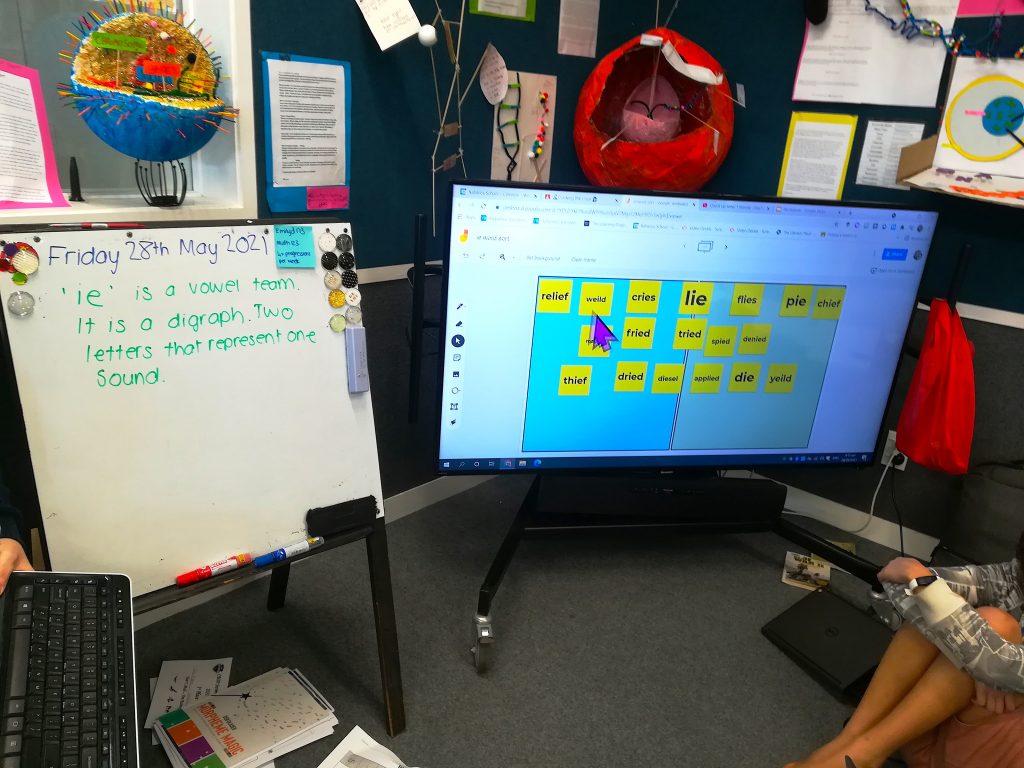
Students discover the different sounds represented:
“Now I want you to work with your partner: in a minute, when you open your Chromebooks, you’ll see this Jamboard is now in your Google Classroom. What you need to do is read each word, and decide what sound the vowel team ‘ie’ is representing. Then you will move the words into groups with the same sound – one sound on each of the coloured boxes.”
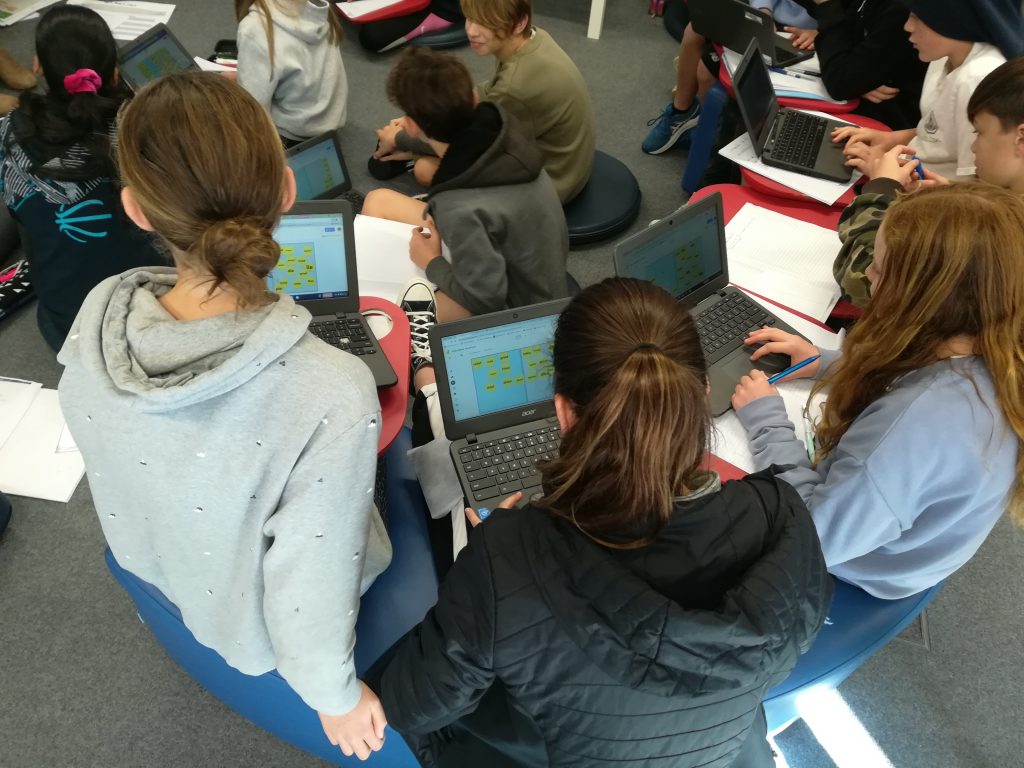
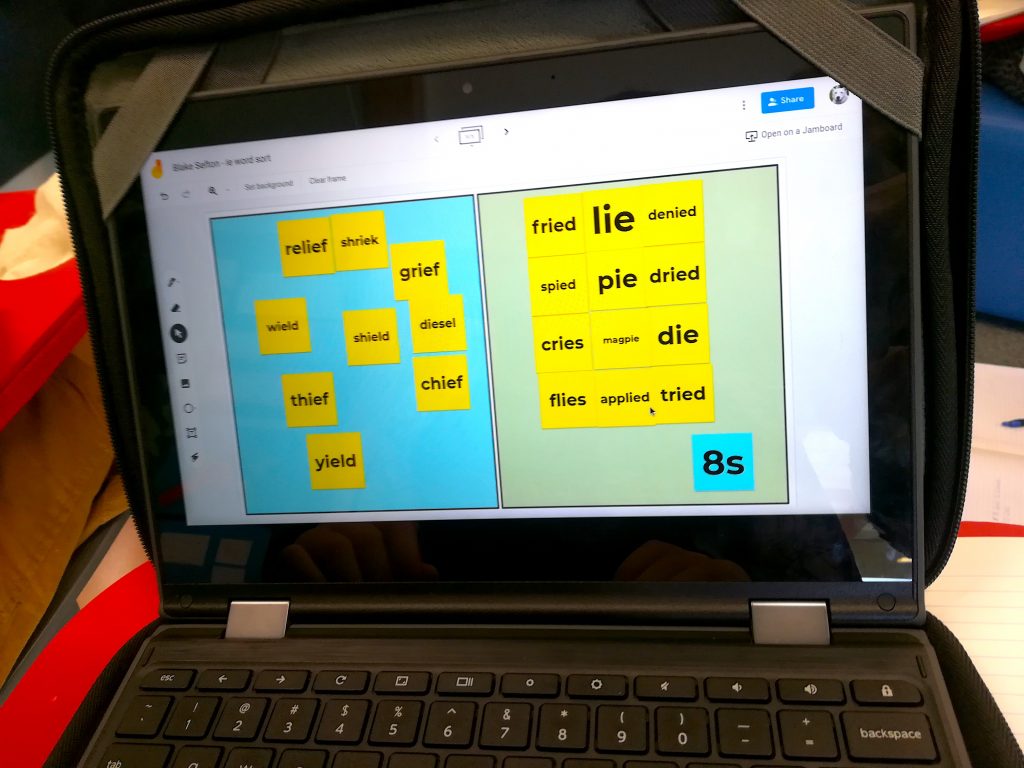
“What did you discover about the two groups of words?”
Jackson: “In this group, the ‘ie’ spells the /ee/ sound, like in chief and shield. In the other group, the ‘ie’ spells the /ī/ sound, like in lied and pie.”
“Great! Now we’ll sort them together and you can all check your own Jamboards. I’ll point to and read the word, you say the vowel sound the ‘ie’ digraph represents. LIE.”
Students: “/ī/”
Whaea Denise moves the word to one of the sides, and continues for each word, grouping like sounds together.
“So we have found out that the vowel digraph ‘ie’ can represent two sounds: /ē/ as in shield, and /ī/ as in pie.” (writes those two pieces of information on the whiteboard, adding to the definition). “Write that into your book, please.”
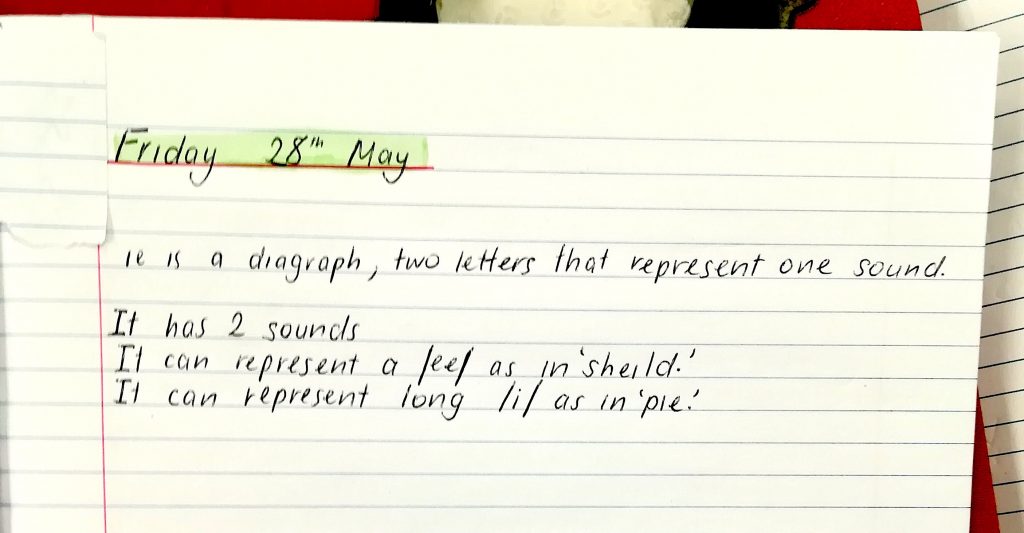
Students say and write the new pattern:
“Now we’re going to do our writing across the page. As you write the digraph ‘ie’, I want you to say the sound to yourself. “/ī/” {Whaea Denise models on the whiteboard, saying the sounds. Students write ‘ie’ across the page 5 times, saying /ī/ each time they write the digraph – multisensory component: hear the sound, write the symbol, see the symbol}
Manaia asks: “Are those slashes?”
“Yes,” Whaea Denise responds, “remember we talked about how when we’re writing down sounds, we will use slashes like this to tell our brain we’re talking about a sound, not a spelling pattern.”
The class begins to write across the line (they know the routine!). “Jayton is winning right now at saying the sounds!” {everybody increases the volume!}.
“Now here’s a word with ‘ie’ representing /ī/: write ‘magpie’ across the page, saying the sounds. Underline the /ī/ sound.”
{This is modelled on the whiteboard and the students get writing and sounding out.}
The process is repeated for the /ē/ sound:
“Now write ‘ie’ across the page five times, saying the other sound, /ē/ each time you write the digraph”. Whaea Denise models this on the whiteboard and the students do the same in their book. The word ‘shield’ is given as an example word to write and sound out next.
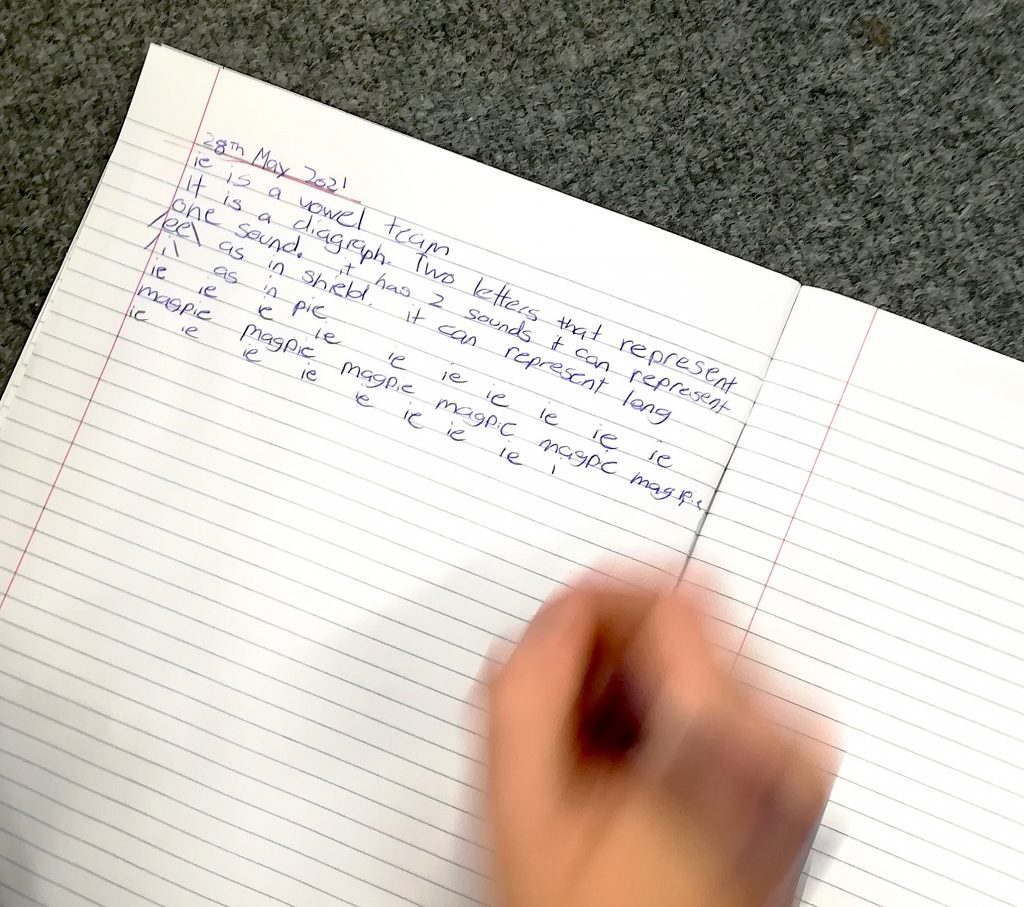
Decoding (reading) words with the new pattern, building fluency:
“I’m going to put this timer on that counts UP like this.”
“In your pairs, you’re going to open your Jamboard, and one person will read these words as accurately and as quickly as you can. Then look up at the timer, and record your time.”
“Are you ready? 3, 2, 1 go”
This is repeated for the other partner’s turn.
“Right, now I want you to try and beat your own time – first person, go again.”
The kids read again – there is lots of excitement and happy calls of “yessss” as they beat their own times.
Students encode (write) words with the new pattern: Tap it, Map it, Zap it
Whaea Denise puts up an A3 sheet on her whiteboard to model how to do the next activity.
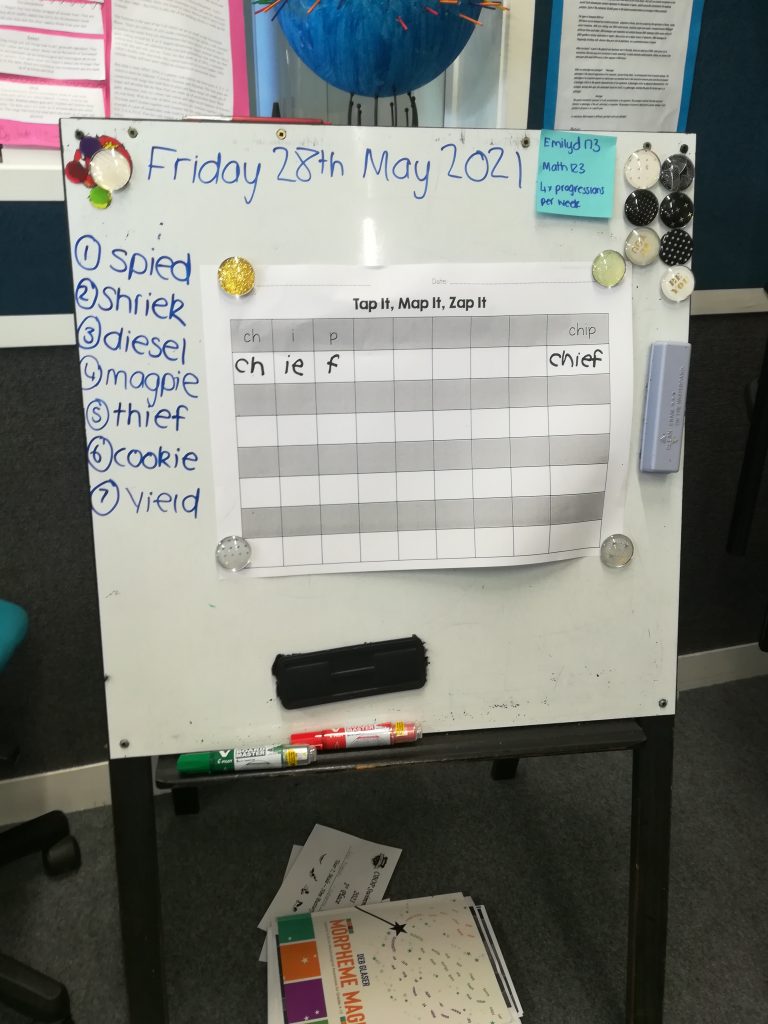
“This is called Tap it Map it Zap it.”
“I’m going to say the word, like “chief”. We’re going to TAP the sounds, one in each box, like this. /ch/ (tap) /ee/ (tap) /f/ (tap).”
“Then we’re going to MAP the letters to each sound – that means connect the letters to the phonemes. Like this: /ch/ ch – /ē/ ie – /f/ f” (writing the sounds and saying them aloud, one in each box).
“When we say the sounds out loud while we write them, you are helping your brain create a neural pathway between the letters and the sounds, which is how you store the spelling in your memory.”
“So we have TAPPED the sounds, MAPPED the letters to the sounds, now we will ZAP the word. Write the word in one go over here, saying the sounds while you write them. Like this.” {demonstrates writing chief, saying “/ch-ē-f/ chief” while writing}.
“Now it’s your turn. Glue the sheet into your Code Cracking book and Tap, Map and Zap these words on the board. All these words have our digraph ‘ie’ in them.”
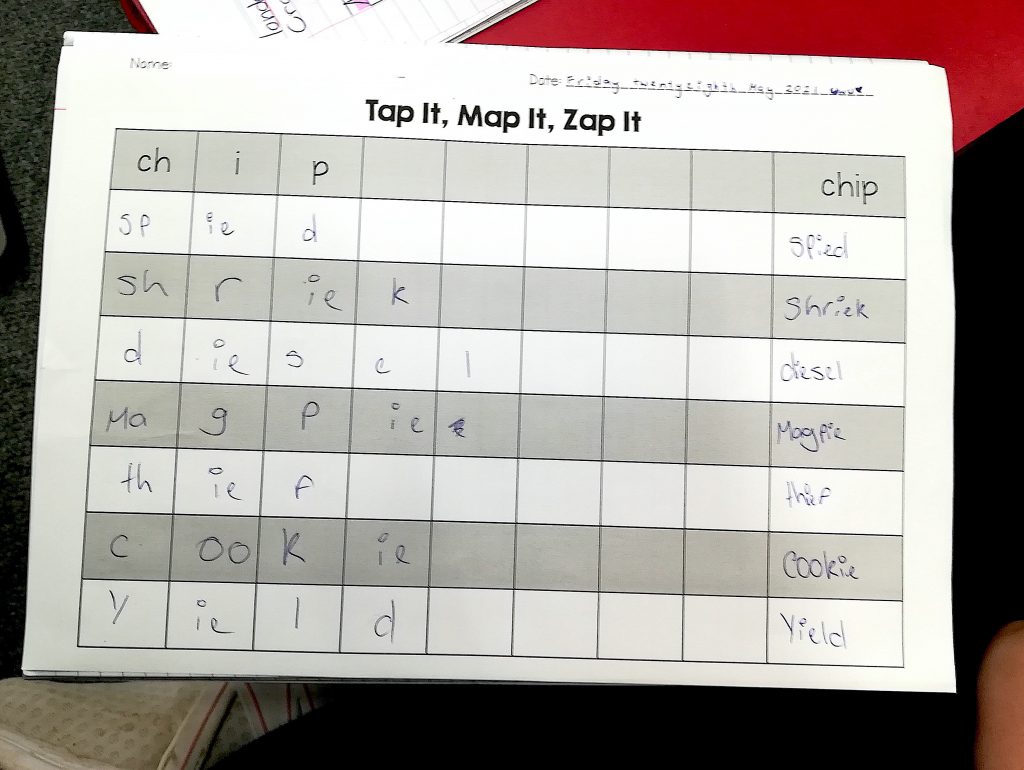
Whaea Denise moves around the room, supporting any students needing her help to participate in this learning activity. After 5 minutes, she comes back to the front and uses the large poster to review the activity with the students – saying and writing the sounds in the boxes. The class mark their own work as she goes.
┉┉┉┉┉┉
This lesson took 45 minutes, and formed the beginning of the teaching cycle. Further review of the spelling pattern and sounds will be needed, as well as plenty more guided practice reading and writing words with the pattern, and moving into writing phrases and sentences (dictation) with increasing independence / less scaffolding.
┉┉┉┉┉┉
Let’s hear it for the awesome Whaea Denise – for getting stuck in to Structured Literacy to help her learners crack the written code…
AND for generously sharing her planning…
AND for allowing me to write all about it to help other teachers wanting to get started.
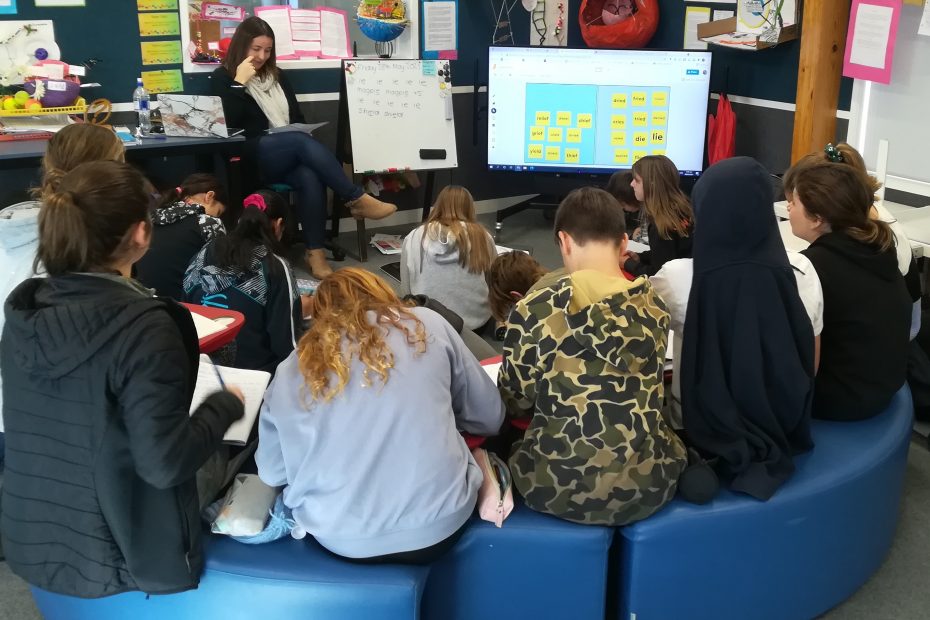
Fantastic lesson plan to support teaching the code! Thank you so much for sharing, Whaea Denise! Yvonne.
Thank you for sharing. These students ae being empowered to learn beyond just a few sight words to now having tools to decode and encode many, many words. Well done.
Thank you so much Whaea Denise, this has really supported me to understand how I can now plan and teach a lesson to help my tamariki crack the code!
Thanks so much for sharing. I’m trying to get my head around how to plan for a week’s learning and this has helped a lot!
Wow this is awesome. And your school is just down the road from mine. Thanks you for sharing,